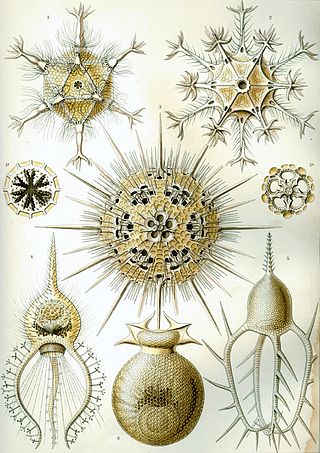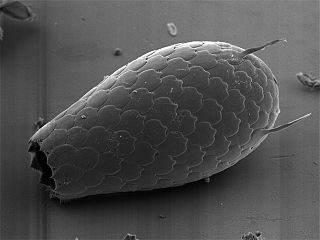
Nucleariida is a group of amoebae with filose pseudopods, known mostly from soils and freshwater. They are distinguished from the superficially similar vampyrellids mainly by having mitochondria with discoid cristae, in the absence of superficial granules, and in the way they consume food.

The centrohelids or centroheliozoa are a large group of heliozoan protists. They include both mobile and sessile forms, found in freshwater and marine environments, especially at some depth.

Heliozoa, commonly known as sun-animalcules, are microbial eukaryotes (protists) with stiff arms (axopodia) radiating from their spherical bodies, which are responsible for their common name. The axopodia are microtubule-supported projections from the amoeboid cell body, and are variously used for capturing food, sensation, movement, and attachment. They are similar to Radiolaria, but they are distinguished from them by lacking central capsules and other complex skeletal elements, although some produce simple scales and spines. They may be found in both freshwater and marine environments.

The Heliomonadida are a small group of heliozoan amoeboids that are unusual in possessing flagella throughout their life cycle.

Cercozoa is a phylum of diverse single-celled eukaryotes. They lack shared morphological characteristics at the microscopic level, and are instead defined by molecular phylogenies of rRNA and actin or polyubiquitin. They were the first major eukaryotic group to be recognized mainly through molecular phylogenies. They are the natural predators of many species of bacteria. They are closely related to the phylum Retaria, comprising amoeboids that usually have complex shells, and together form a supergroup called Rhizaria.

Phaeodarea, or Phaeodaria, is a group of amoeboid cercozoan organisms. They are traditionally considered radiolarians, but in molecular trees do not appear to be close relatives of the other groups, and are instead placed among the Cercozoa. They are distinguished by the structure of their central capsule and by the presence of a phaeodium, an aggregate of waste particles within the cell.

The tectofilosids are a group of filose amoebae with shells. These are composed of organic materials and sometimes collected debris, in contrast to the euglyphids, which produce shells from siliceous scales. The shell usually has a single opening, but in Amphitrema and a few other genera it has two on opposite ends. The cell itself occupies most of the shell. They are most often found on marsh plants such as Sphagnum.

Imbricatea is a class of Rhizaria characterised by silica scales. It is sometimes described as "Imbricatea/Silicofilosea", due to the similarity of those two groupings. Imbricatea is divided into the orders Euglyphida and Thaumatomonadida.

The sarcomonads or class Sarcomonadea are a group of amoeboid biciliate protists in the phylum Cercozoa. They are characterized by a propensity to move through gliding on their posterior cilium or through filopodia, a lack of scales or external theca, a soft cell surface without obvious cortical filamentous or membranous skeleton, two cilia without scales or hairs, tubular mitochondrial cristae, near-spherical extrusomes, and a microbody attached to the nucleus.
The katablepharids, a group of heterotrophic flagellates, have been considered as part of the Cryptista since katablepharids were described in 1939. Although they differ from other cryptophytes and have even been proposed to be alveolates, early 21st century research suggests they are related to cryptophytes.
Pinaciophora is an amoeboid genus of Heliozoa of uncertain affinity, previously classified as Rhizaria.
Rabdiophrys is a genus of amoeboid rhizarians. It has 19 species, including the species Rabdiophrys anulifera.
Kiitoksia is a genus of aquatic protist. The taxonomic position of the genus is still uncertain and it has not found a robust location in any subgroup.

Haptista is a proposed group of protists made up of centrohelids and haptophytes. Phylogenomic studies indicate that Haptista, together with Ancoracysta twista, forms a sister clade to the SAR+Telonemia supergroup, but it may also be sister to the Cryptista (+Archaeplastida). It is thus one of the earliest diverging Diaphoretickes.
Endohelea is a proposed clade of eukaryotes that are related to Archaeplastida and the SAR supergroup. They used to be considered heliozoans, but phylogenetically they belong to a group of microorganisms known as Cryptista.

Phaeocystida, also known as Phaeocystina, is a group of cercozoans in the class Phaeodarea. It was first described by Ernst Haeckel in 1887 and treated traditionally as a suborder, but later was raised to order level until Cavalier-Smith's classification lowered it again to suborder level. It belongs to the order Eodarida, characterised by simpler silica skeletons or a lack thereof.
Corbihelia is a proposed phylum of eukaryotes.
Microheliella is a monotypic genus of protists containing the sole species M. maris, first described in 2012. It has a variety of unusual morphological characteristics which make its broader classification difficult. These include a centrosome with two concentric granular shells and axopodia much simpler in structure than in visually similar protists.
The paracercomonads are a group of cercozoan protists. Taxonomically, they comprise the family Paracercomonadidae, order Paracercomonadida and subclass Paracercomonada. Due to their morphological similarities to the cercomonads, members of this family were grouped with Cercomonas and similar taxa from the beginning. However, their similarities are due to convergent evolution.
Tetrahelia is a genus of four-ciliated protists belonging to the Endohelea, a group of heterotrophic eukaryotes previously considered heliozoa. It is the only genus in the family Tetraheliidae and order Axomonadida. It is a monotypic genus, containing the sole species Tetrahelia pterbica, previously classified as Tetradimorpha.










